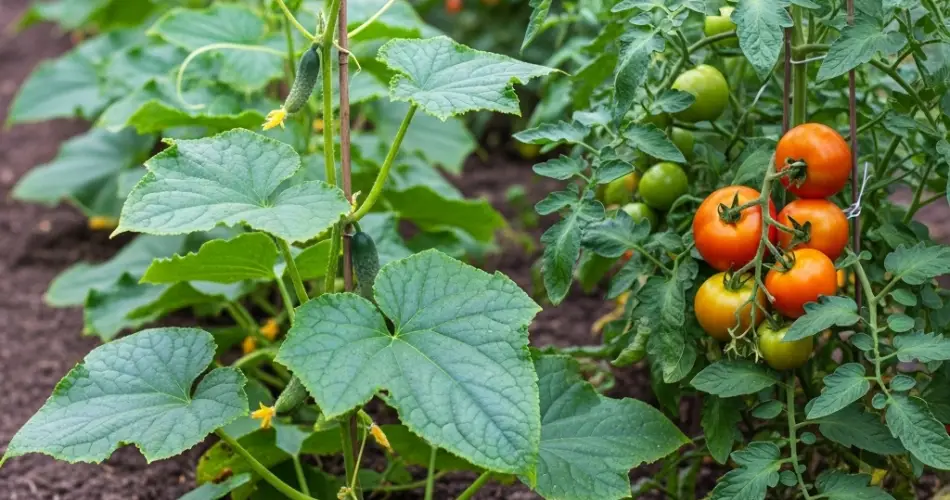Growing tomatoes and cucumbers can be incredibly rewarding, especially when the harvest is plentiful. But did you know that a simple kitchen ingredient could be the secret to increasing both the quantity and quality of your crops? This easy and cost-effective method uses just one tablespoon of a common household item to supercharge your garden and improve plant productivity.
The Power of Baking Soda in the Garden
The secret ingredient is baking soda (sodium bicarbonate). It’s widely known for its many household uses, from cleaning to deodorizing, but it’s also a hidden gem for gardeners. When applied correctly, baking soda can improve the health of your tomato and cucumber plants, reduce the risk of disease, and stimulate better fruit development.
Why Baking Soda Works
Baking soda has natural antifungal and antibacterial properties. It helps create an alkaline environment on plant surfaces, which discourages the growth of fungi such as powdery mildew and blight—common problems in tomatoes and cucumbers. By reducing the presence of harmful fungi and bacteria, your plants can focus their energy on growing and producing fruit instead of fighting off diseases.
Additionally, baking soda helps regulate soil pH. Tomatoes and cucumbers thrive in slightly acidic to neutral soils (pH 6.0–7.0). If the soil becomes too acidic, it can stunt growth and reduce yields. Baking soda, in moderation, can help balance overly acidic conditions, making nutrients more accessible to your plants.
How to Use Baking Soda for Maximum Benefit
Here is a simple and effective way to apply baking soda to your tomato and cucumber plants:
You will need:
-
1 tablespoon of baking soda
-
1 liter of water
-
A spray bottle or watering can
Instructions:
-
Mix the solution – Dissolve 1 tablespoon of baking soda in 1 liter of water. Stir until fully dissolved.
-
Apply to plants – Use a spray bottle to mist the solution onto the leaves of your tomato and cucumber plants, making sure to reach the undersides where pests and fungi often hide. You can also water the base of the plants using a watering can with the same solution.
-
Use weekly – Apply once a week, preferably in the morning or late afternoon to avoid the hottest part of the day. Avoid spraying during high heat or full sun to prevent leaf burn.
This weekly treatment helps protect plants from diseases and promotes a healthy growing environment, leading to a more abundant harvest.
Additional Tips for a Bountiful Harvest
While baking soda is a powerful aid, combining it with good gardening practices will further improve your results:
-
Water wisely – Keep soil evenly moist but not waterlogged. Watering at the base of the plants prevents fungal diseases caused by wet foliage.
-
Mulch the soil – Apply a layer of mulch around your plants to retain moisture, suppress weeds, and regulate soil temperature.
-
Feed your plants – Tomatoes and cucumbers are heavy feeders. Supplement with compost or a balanced organic fertilizer every few weeks to ensure they get all the nutrients they need.
-
Support and prune – Use stakes or cages to support tomato plants and keep cucumbers off the ground. Prune unnecessary leaves and side shoots to direct energy to fruit development.
What to Expect
With regular use of the baking soda solution and proper care, you can expect:
-
Fewer fungal issues on leaves and stems
-
Healthier and more vigorous plants
-
Increased flowering and fruit setting
-
Improved size and flavor of tomatoes and cucumbers
Many gardeners report seeing noticeable improvements within just a couple of weeks of starting this simple routine. It’s a low-cost, non-toxic method that fits perfectly into organic gardening practices.
A Natural Boost for Your Garden
Gardening doesn’t have to rely on expensive chemicals or complicated treatments. Sometimes, the most effective solutions are already in your kitchen. A single tablespoon of baking soda can help you grow healthier tomato and cucumber plants, reduce common garden problems, and ultimately enjoy a more abundant harvest. Give this method a try and watch your garden thrive!



